Honeysuckle "Chernichka": description and agricultural technology
Honeysuckle - an irregularly shaped berry. We habitually imagine round fruits, red-raspberry color. Honeysuckle is distinguished by its elongated appearance and blue color. Breeders breed many different plant species. Not all of them, however, are edible, but some have good taste. For example, Chernichka honeysuckle is an interesting and tasty variety.
Content:
- Description of the variety
- Landing: timing and rules
- Care Tips
- Diseases and pests
- Useful properties of berries
Description of the variety
Honeysuckle "Chernichka" is represented by an elongated, slightly flattened shape with a light blue tint. According to its taste characteristics, it has a rather sweet aftertaste. When ripe, it practically does not crumble from the branches, preferring to keep on a tight-fitting stalk. Ripe berries can be tasted from mid-July. It is for the duration of ripening that the variety is classified as a late species. By their appearance, berries are very similar to blueberries. Apparently, due to this, honeysuckle received such a cute name as "Chernichka".
Each berry has a small size - it stretches in length by almost 2 cm, and weighs up to 1 g.
Up to 2.5 kg can be harvested from one bush. fresh fruits. This suggests that the variety is very fertile and never offends with a lack of harvest. Bush honeysuckle represents straight shoots and reverse conical crown. The leaves of the plant are small, practically do not exceed the size of the berries. They are light green in color. The greenery is tough, with a well-visible system of veins.
For planting, both partial shade and sunny areas are suitable. In the choice of soil, honeysuckle is unpretentious. It doesn't matter whether the soil is poor or fertile. The main thing is the presence of a sufficient amount of nutritious moisture. Berries are most often used for curling preserves, preserves and in culinary dishes. The shrub is not afraid of either strong frosts or northern winds blown through and through. Also, honeysuckle is not susceptible to diseases and pests. Thus, Chernichka stands out not only for its taste, but also for its ability to survive in any conditions.
Landing: timing and rules
Planting can be done from early spring to late autumn. The shrub can withstand temperatures as low as -50 C. Even flower buds are not afraid of frost, continuing to swell at sub-zero temperatures.
Landing features:
- Although the blue berry can be planted at any time, it is best not to do it in May-June. It is this period that is characterized by increased growth and formation of fruit berries. If you disturb the shrub from its familiar place, it can throw off all the berries and leave without a crop.
- It is recommended to plant in a bright, sunny place. Blueberry also tolerates partial shade, but yields significantly less yield or may completely refuse to bear fruit. You should not take risks and experiment, choosing a place in the shade of trees.
- When planting in the spring, you should hurry up and plant a shrub until the fruit buds swell. But the best option for planting is mid-autumn - October. Before frost, the plant will have time to take root in a new place and gain nutrients for the coming winter.
- Before landing, it is worth choosing the best site for permanent residence.For these purposes, a swampy area in a lowland is suitable, where the plant will be protected from winds and drafts, where there is a lot of light.
- If the soil is significantly depleted, then it is recommended to feed it organic and mineral additives.
- Before boarding root system the bush is carefully examined. If roots are broken or otherwise damaged, they are removed. Rhizomes exceeding 30 cm in length are also cut, shortening them to the desired size.
Sapling planting rules:
- The hole for the honeysuckle needs to be dug at least 40 cm in width and depth. Up to 12 kg of rotted cow or horse manure is added to the hole. If there is no manure, then humus should be used. In addition to natural fertilizers, it is recommended to add: double superphosphate (100 gr.), wood ash (300 gr.), Potassium sulfate (30 gr.).
- All components of the prepared soil are thoroughly mixed and formed in the form of a small mound. A plant is installed on it.
- The roots are straightened and densely covered with soil substrate. From above, the earth must be tamped.
- After planting, it is necessary to water abundantly. Next to the stem, you need to make a small indentation at a distance of 30 cm from the stem. Pour a whole bucket of water into the resulting bath. The hole is necessary so that all the nutrient moisture gets to the roots of the honeysuckle, and does not spread over the garden bed.
- After the liquid is completely absorbed, the area around the trunk must be mulched. For this, peat, humus or dry soil are suitable.
Care Tips
To honeysuckle developed well and gave rich harvests, she needs the same as other trees and shrubs - watering, fertilizing, loosening, mulching and cropping. All this must be done in a timely manner, avoiding stagnation and overgrowing of the bush.
How to care for a shrub:
- In the first 3 years after planting, the shrub requires careful trimming... If left unchanged, the rapidly growing greens will quickly become entangled in their own branches. In this case, the plant looks neglected and unkempt, gives little yield.
- Also, do not overlook the periodic weeding of the weeds around the stem, as well as loosening. The process of digging up soil in the root zone should be carried out no deeper than 7 cm. If deeper, you can damage the rhizomes, which tend to lie not very deep, being almost on the surface.
- Honeysuckle is demanding watering. Abundant irrigation is necessary during the growing season, when there is an active formation of greenery and fruit buds. If the weather is dry, hot, then watering should be increased. This is especially important when berries are poured. If there is a lack of life-giving moisture, then the berries ripen with the present bitterness. Otherwise, in rainy weather, with a temperature not exceeding + 25 + 30 C, watering should be done only when the soil dries up, but not less than 3-4 times per season.
Thus, caring for the shrub does not require much effort. But if you follow these simple rules, then you can grow a large bush that gives good, sweet, fragrant berries.
Diseases and pests
Although it is believed that Blueberry is not susceptible to diseases and pests, it is nevertheless periodically affected by harmful bacteria, viruses, or even fungi. In addition, it happens that insect pests attack the tree.
The main pests for honeysuckle are:
- Aphid - feeds on sap of leaves and stems. Branch growth slows down, internodes are shortened. The presence of aphids is complemented by the yellowing of the foliage and its curling. In order to prevent the appearance of a harmful insect, it is necessary to spray the entire plant with preparations for the control of "Aktellik" (0.2%), "Confidor" (0.2%) or Rogor (0.2%) at the moment before the budding begins. This is necessary to neutralize the eggs that have overwintered on the trunk.
- Scabbard - the appearance of small tubercles on the trunk of a bush, which means that the tree is populated with a scabbard. She lays eggs under her shield, in which they hibernate, and in the spring they crawl out again and fill all the branches. They feed on the juice of young animals. You can get rid of them by spraying in 2 passes with Aktellikom (0.2%), Rogor (0.2%) or Confidor (0.15%);
- Leaf worm - sucks juices and spoils the appearance of buds, greens, fruits or young shoots. It is recommended to eliminate irrigation with chemical insecticides - "Eleksar", "Inta-Vir";
- Mealybug - when it appears, the tree methodically begins to dry out. Damaged areas should be cut off and sprayed in June-July with chlorophos, Aktellik or Rogor.
The most common diseases of honeysuckle are powdery mildew and spotting. To prevent any disease of the plant. In the spring, before the formation of flowers, it should be sprayed with urea (5%) for prophylaxis. Or, after the foliage has completely fallen off, walk along the bare branches for 7% nitrate.
If any disease occurs, the plant should be disinfected.Topaz"," Fundazol "or" Tsinebom ".
In case of heavy infestation, cut off all bruised areas to a healthy space and burn them. In order for a plant to develop without the proximity of pests or the acquisition of diseases, it is required to control the condition and, at the first sign, neutralize the enemy.
Useful properties of berries
The appetizing honeysuckle berry contains a large amount of different vitamins, minerals and other components:
- Iron, potassium, sodium, phosphorus, magnesium, iodine, silicon, zinc, calcium, copper (trace elements).
- Vitamins C, A, group B (1,2,9).
- Tannins.
- Pectins.
- Acid - amber, oxalic, citric, apple.
- Glucose, galactose, fructose, sucrose.
Due to the high content of so many nutrients, eating honeysuckle helps to improve the following processes:
- Increases gastric secretion.
- Promotes a more thorough digestion of gastric juice.
- It has a lot of positive effects - diuretic, choleretic, laxative.
- Strengthens the immune system and acts as an antiviral agent.
Traditional medicine uses fruit juice honeysuckle for the treatment of intestinal disorders, stomach diseases, anemia and hypertension. Berry juice promotes skin regeneration in case of dermatitis. Conjunctivitis can be treated with eye rinsing. For diseases of the nasopharynx, rinsing with heated juice relieves pain and neutralizes the inflammatory process.
Thus, honeysuckle is not only just a healthy berry, it can heal many types of diseases. The main thing is correct planting and proper care of young shrubs. Then the ripe berry can be enjoyed for a long time after ripening.
More information can be found in the video:





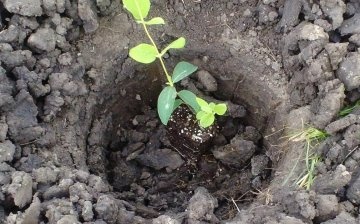
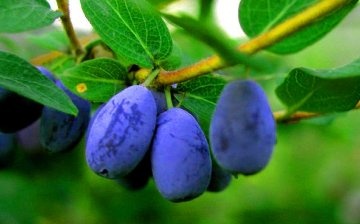

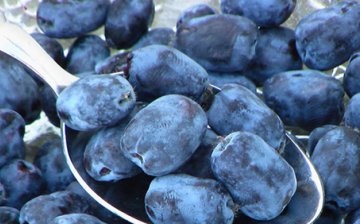







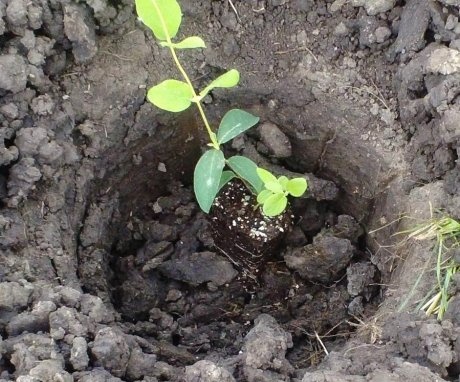
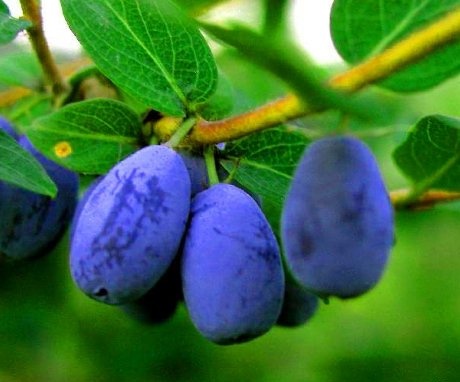

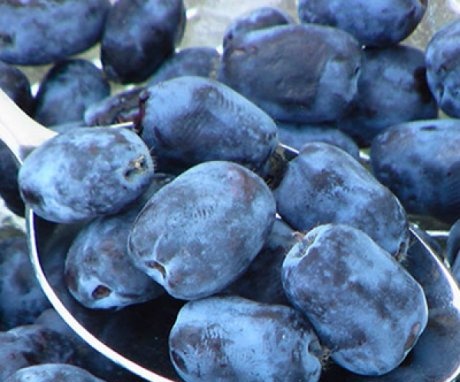
I have not yet met this berry, in the photo it resembles an Ugorka plum, but much smaller in size. If the shrub has such a high frost resistance, then, in our region, honeysuckle will definitely take root. I'll try to plant it in the fall.